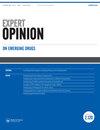Emerging drugs for the acute treatment of relapses in adult neuromyelitis optica spectrum disorder patients
IF 2.7
3区 医学
Q2 PHARMACOLOGY & PHARMACY
引用次数: 6
Abstract
ABSTRACT Introduction Neuromyelitis optica spectrum disorders (NMOSD) are rare but often devastating neuroinflammatory autoimmune diseases of the central nervous system. Acute treatment is critically important and it should be initiated early and aggressively, as relapses result in severe residual disability. Acute treatments are still based on clinical experience and observational studies. The most commonly used treatments are steroids and plasmapheresis. Several new treatments to improve management and recovery after relapses in NMOSD are currently under investigation. Areas covered This review discusses current and the most recent advances in active development of phase II/III clinical trials for acute treatment options and therapeutic strategies that can help management improvement of NMOSD during a relapse. These treatments include bevacizumab, ublituximab and HBM9161. Expert opinion NMOSD relapses require prompt evaluation and timely treatment to restore function and mitigate disability. Timing is critical. Plasmapheresis showed better outcomes in terms of recovery when compared to high-dose intravenous methylprednisolone alone. Some groups suggest that plasmapheresis could be considered as an initial treatment approach in different clinical scenarios due to its higher effectiveness. Future research and/or real-world data will establish the advantages and disadvantages of these new treatments and define the appropriate patient profile.新兴药物急性治疗复发的成人视神经脊髓炎谱系障碍患者
摘要简介视神经脊髓炎谱系障碍(NMOSD)是一种罕见但往往具有破坏性的中枢神经系统神经炎性自身免疫性疾病。急性治疗至关重要,应尽早积极进行,因为复发会导致严重的残余残疾。急性治疗仍以临床经验和观察研究为基础。最常用的治疗方法是类固醇和血浆置换。目前正在研究几种新的治疗方法,以改善NMOSD复发后的管理和恢复。涵盖的领域本综述讨论了积极开发急性治疗方案和治疗策略的II/III期临床试验的当前和最新进展,这些试验有助于在复发期间改善NMOSD的管理。这些治疗方法包括贝伐单抗、伊立妥昔单抗和HBM9161。专家意见NMOSD复发需要及时评估和及时治疗,以恢复功能并减轻残疾。时机至关重要。与单用大剂量静脉注射甲基强的松龙相比,血浆单采在恢复方面显示出更好的结果。一些研究小组认为,血浆置换术由于其更高的有效性,可以被视为不同临床情况下的初步治疗方法。未来的研究和/或真实世界的数据将确定这些新疗法的优点和缺点,并定义适当的患者概况。
本文章由计算机程序翻译,如有差异,请以英文原文为准。
求助全文
约1分钟内获得全文
求助全文
来源期刊
CiteScore
5.90
自引率
0.00%
发文量
28
审稿时长
>12 weeks
期刊介绍:
Expert Opinion on Emerging Drugs (ISSN 1472-8214 [print], 1744-7623 [electronic]) is a MEDLINE-indexed, peer-reviewed, international journal publishing structured reviews on Phase II and Phase III drugs/drug classes emerging onto the market across all therapy areas, providing expert opinion on their potential impact on the current management of specific diseases.

 求助内容:
求助内容: 应助结果提醒方式:
应助结果提醒方式:


